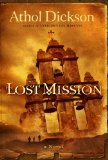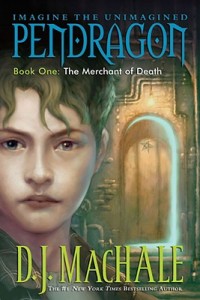
Lost Mission by Athol Dickson, a review
Published by Simon & Schuster, 2009, 345 pages
Genre: “Magical realism” according to the publisher. I will call it supernatural suspense. Suitable for teens and adults.
There are two alternating story lines, each with its protagonist, that unfold as the book progresses. One takes place around 1772 and the other in modern times. Both story lines focus on the same location near Los Angeles.
The two stories, while seemingly not similar at first, become more and more alike. A small three-paneled painting is common to both stories, as is a certain character, described as an Indian with shining hair, who I think must be an angel.
In 1772, three Franciscan friars and some Spanish soldiers set out on a missionary journey northward from Baja California. They eventually start a mission in a desert spot near an Indian village. We readers know from the beginning that the mission fails and that just one of the three friars, Fray Alejandro, and an Indian miraculously survive the fire that burns the place down.
The sad tale of the failed mission unfolds as the book progresses. The other two friars, keeping secrets, are at cross purposes. The superior of the three routinely mistreats the Indian converts. Through it all, Fray Alejandro works on his assigned task, painting the three-panel altarpiece painting, but oddly cannot make any headway.
In the modern tale, a devout young Mexican woman, Lupe, feels called to travel to the US and confront Americans with their wickednesses. She’s a missionary to the lost in the modern U.S. Miraculously she survives walking through the desert to California, carrying two panels of the three-panel painting (given to her by the village priest). We readers learn that the painting shows something extraordinary–apparently Lupe’s own face is in it, along with faces of others.
The other two main characters connect with Lupe in Orange County, California, a suburb of Los Angeles. Eventually we can figure out that these two characters, a rich man and a preacher, are given parallel personalities to the wayward friars in the earlier story.
As I read the modern day and historical stories, I tried to guess the outcome for the modern story and the reason for failure for the historical story. I must say, I missed the mark widely for both. I did figure the painting had something to do with the outcome, and that was true.
Both stories contrast grace and redemption to punitive, limited, prideful versions of faith. The book will cause a wise reader to stop and take stock: am I acting like a prideful pharisee? Where am I unrepentant? What are my own sins that I, a sinner, am too blind to see?
This complex book is intended for adults and would make a fine read for teenagers as well. There are even some discussion questions included at the end.
Full of symbolism and parallels, this work is a reach feast for a reader, hard to put down and wonderful to savor.–Phyllis Wheeler
This review is part of the Christian Science Fiction/Fantasy Blog Tour.
Check out the author’s websites:
Check out what others on the blog tour are saying about this book:
Brandon Barr
Keanan Brand
Amy Browning
Valerie Comer
CSFF Blog Tour
Stacey Dale
D. G. D. Davidson
Jeff Draper
April Erwin
Timothy Hicks
Jason Isbell
Becky Jesse
Cris Jesse
Jason Joyner
Julie
Carol Keen
Krystine Kercher
Dawn King
Rebecca LuElla Miller
New Authors Fellowship
John W. Otte
Donita K. Paul
Crista Richey
Chawna Schroeder
James Somers
Steve Trower
Fred Warren
Phyllis Wheeler
KM Wilsher

